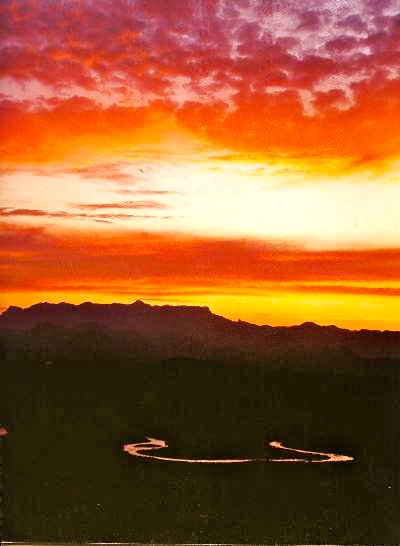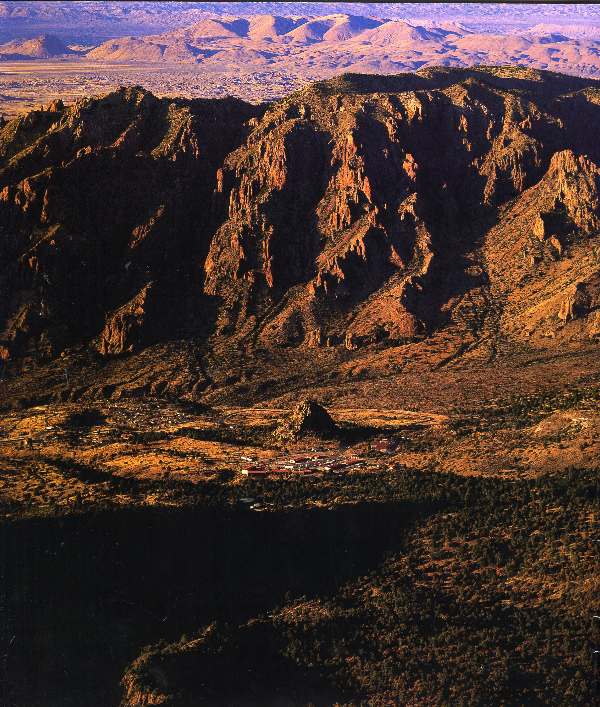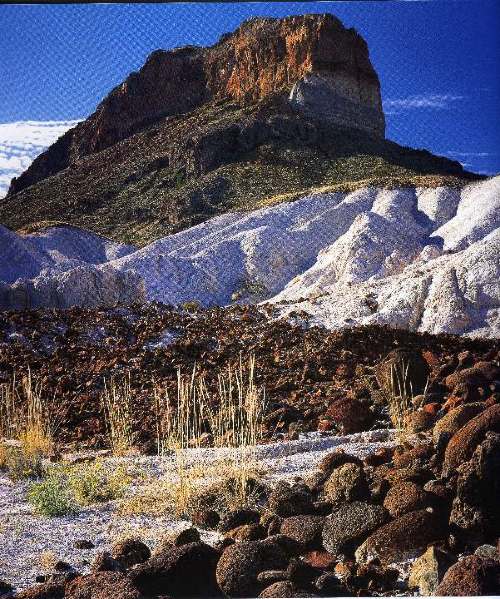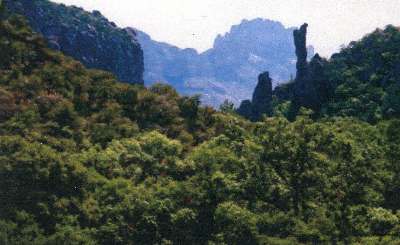
Big Bend
National Parks

| Route 66 | Cities | Beaches |
 |
Big Bend National Parks |
 |
|
All of our expeditions have taken us into magnificent places where we have had great experiences. However, Big Bend is the most unique. We say this for two reasons. First, the experiences we have had there have been the most different from anything we've ever experienced anywhere else. Even in the Grand Canyon, the Wind River Wilderness or Hatteras Island, we could find some things in common with other places. Not Big Bend. For two weeks, it's like we're on Mars. Plants, animals, sky, landforms, people, birds, everything. It's a Lost World. Second, Big Bend offers more variety than any other trip. Nowhere else we go has so many different things to do, sometimes two or three in one day. |
We sandsurf the dunes, tour a ghost town, walk through an Old West movie set, wake up in the middle of the night to Javelinas in our camp, watch Roadrunners racing us down the highway, wander among huge cacti, spend the night in an Adobe hacienda, dodge Peregrine Falcons while climbing to Emory Peak, eat Chile Rellenos and Texas steak, boat the San Antonio River, shop in a Mexican Marketplace, camp under Pecan trees, and bow in silence at The Alamo. We meet real working cowboys, professional reptile breeders hunting specimens for zoos, and Border Patrol officers looking for illegal immigrants. And through all this we spend a week inside a giant volcanic crater, hiking and backpacking some of the most spectacular trails in North America. |
A word of caution, though : Big Bend is not a first trip for any group. This is a harsh, isolated, hot, dry land. It is not a place to learn outdoor skills. You need to already know what to do in varying conditions and have practiced those skills until they are second nature. They rescue people here and sometimes they get to them too late. There is no cell phone service and the place is so vast that it is very unlikely another group will just happen by. You will bring your water with you up switchbacks that seem like they'll never end. Afternoon heat will make people irritable, and if you're not a smooth working unit, tempers will begin to flare and simple chores will become the subject for petty bickering. We've met many Scout groups here from all over the country, and they were having a wonderful time, but there were no first year members among them. Big Bend is the second least visited park in America and the furthest from an interstate, town, railroad or airport. It has the Chihuaha Desert at sea level, the Chisos Mountains at 8,000 ft., and the Rio Grande carving three of the nation's six deepest canyons. Big Bend is home to Mountain Lions, Bears, Javelinas (Peccaries, usually mistaken for Wild Boars---it's pronounced Have-A-Leenas), Mexican Gray Wolves, Jackrabbits, Kangaroo Rats, Peregrine Falcons, Roadrunners, Burrowing Owls, Vultures, Banded Geckos and Alligator Lizards. Its plant community includes 12 kinds of cacti, and another dozen trees and bushes and flowering grasses specially adapted to the heat and lack of humidity, . Big Bend is also a geologic showcase. It was formed by volcanic action and the collisions of huge crustal blocks, then eroded by wind and water. The result is a bizarre landscape of upthrusts, fault blocks, pinnacles, balanced rocks, polished bowls, sculptures, cliffs, dikes and crags.
|
 |
 |
Ecologically, the park is a landscape of hot, dry desert floors with mountain plateaus of forests, meadows and mild temperatures. During the winter, backpackers utilize the trail network down on the floors, but in the summer months they do their hiking up in the mountains. That includes one of the nation's top 10 trails, the spectacular Chisos Mountain Loop. A five day, four night circle, the loop includes the South Rim, with views extending across into Mexico, Boot Canyon, pictured at left, and Emory Peak, the second tallest point in Texas. The Rio Grande canoeing trip we take carves through Santa Elena Canyon, with cliffs rising straight upward 1500 feet from the water's edge. The campground we use as our base of activities is pictured at top right, to the left of the cone shaped formation. We day hike to The Lost Mine and The Window from this location, then head up into the mountains in the background. |
|
While we are up in the Chisos Mountains, we sidehike down into Blue Creek Canyon and Juniper Canyon and climb to Emory Peak. The South Rim campsites will be closed in June while Peregrine Falcons nesting there teach their young to fly. We spend one afternoon watching these magnificent birds, although we have to camp further around the trail, away from the nesting area. The photo at right is blurred because Momma Falcon was coming after us and we were backing up as we took the picture. We don't have to carry our heavy down sleeping bags and parkas, but we need extra water jugs. We see day time temperatures between 90 - 110. Once the sun sets, the air cools rapidly to a milder 50-70. After the backpacking loop, everyone is hot and dry and ready for a break. So we drive over to Terlingua, on the western side of the park, and stay at the Longhorn Ranch.. Using that as our base, we canoe Santa Elena Canyon, explore old western Lajitas and ghost town Terlingua, and eat authentic Mexican cooking at Tivo's. Coming back across the park, we stay the final night in Adobe haciendas at the Chisos Mountain Lodge. On the way home, we stop overnight in San Antonio, taking in The Alamo, Mexican Market and Riverwalk. |
|
|
|||
|